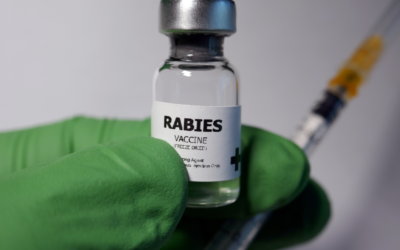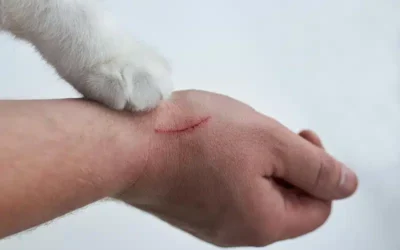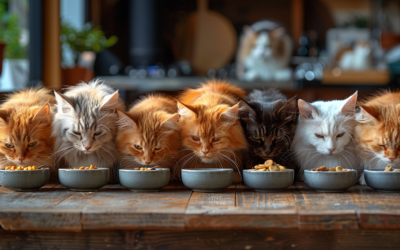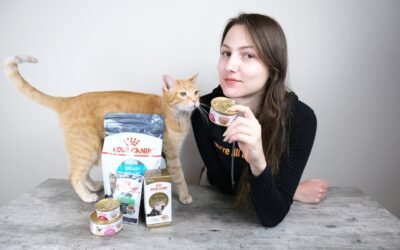In the diverse landscape of Philippine pet care, a notable trend has emerged: the prevalence of repackaged cat food. This analysis aims to examine the intricacies of this practice and elucidate its potential consequences for feline nutrition and health.

Table of Contents
The Landscape of Cat Food in the Philippines
The Philippine pet food market is a dynamic ecosystem, teeming with options that range from premium imported brands to locally produced alternatives. Within this diverse landscape, repackaged cat food has carved out a significant niche, appealing to budget-conscious pet owners and those seeking convenience.
Understanding Repackaged Cat Food
Repackaged cat food, in its essence, refers to bulk cat food that has been divided into smaller portions and repackaged for retail sale. This practice has become increasingly common in local markets, pet shops, and even some larger retail chains across the Philippines.
While repackaging is common in the Philippines, it’s important to understand the nutritional implications. According to the Cornell Feline Health Center, cats have specific nutritional requirements that must be met for optimal health.
The Appeal of Repackaged Options
The popularity of repackaged cat food in the Philippines can be attributed to several factors:
- Affordability: Repackaged options often come at a lower price point compared to branded alternatives.
- Portion Control: Smaller packages allow pet owners to buy only what they need, reducing waste.
- Variety: Repackaging enables consumers to try different types of cat food without committing to large quantities.
- Accessibility: These products are often available in local markets and small shops, making them easily accessible to a wide range of consumers.
The Repackaging Process: From Bulk to Retail
To truly understand the implications of repackaged cat food, we must first delve into the process itself. The journey from bulk packaging to individual retail units involves several steps, each with its own set of considerations.
Sourcing of Bulk Cat Food
The repackaging process begins with the sourcing of bulk cat food. This can come from various channels:
- Local Distributors: Some repackagers source their bulk cat food from authorized local distributors of known brands.
- Imported Bulk Products: Others may import large quantities of cat food directly from overseas manufacturers.
- Local Manufacturers: In some cases, the bulk cat food may be produced by local pet food manufacturers.
The Repackaging Procedure
Once the bulk cat food is acquired, the repackaging process typically involves the following steps:
- Portioning: The bulk food is divided into smaller quantities, usually ranging from 100g to 1kg.
- Packaging: The portioned food is placed into new containers, often plastic bags or small tubs.
- Labeling: New labels are applied, which may or may not include detailed information about the product’s origin, ingredients, or nutritional content.
- Storage: The repackaged products are stored until they are ready for distribution or sale.
Quality Control Challenges
One of the primary concerns with repackaged cat food is the potential for quality control issues. The repackaging process introduces several points where contamination or degradation of the product could occur:
- Exposure to Air: Opening bulk packages exposes the food to air, potentially leading to oxidation and nutrient degradation.
- Handling: The more the food is handled, the higher the risk of contamination.
- Storage Conditions: Improper storage of repackaged products can lead to spoilage or infestation.
Nutritional Considerations of Repackaged Cat Food
The nutritional value of cat food is paramount to feline health. When it comes to repackaged options, there are several factors to consider that may impact the food’s nutritional profile.
Potential for Nutrient Degradation
One of the primary concerns with repackaged cat food is the potential for nutrient degradation. This can occur due to several factors:
- Exposure to Air: Once the original packaging is opened, the food is exposed to air, which can lead to oxidation of fats and degradation of certain vitamins.
- Light Exposure: If the repackaged food is not stored properly, exposure to light can further degrade certain nutrients, particularly vitamins A and B.
- Time Factor: The longer the food sits after repackaging, the more time there is for nutrient degradation to occur.
Variability in Nutritional Content
Another consideration is the potential for variability in nutritional content between packages. This can happen due to:
- Inconsistent Mixing: If the bulk food is not thoroughly mixed before repackaging, some portions may have higher concentrations of certain ingredients than others.
- Settling of Ingredients: During transport and storage, ingredients in dry cat food can settle, leading to inconsistencies when portioning.
Impact on Special Dietary Needs
For cats with specific dietary requirements, the potential inconsistencies in repackaged food can be particularly problematic. Owners of cats with conditions such as diabetes, kidney disease, or food allergies may find it challenging to maintain a consistent diet using repackaged options.
Safety Concerns and Regulations
The safety of repackaged cat food is a topic of significant concern, particularly given the less regulated nature of this market segment in the Philippines.
Regulatory Landscape
The regulation of repackaged cat food in the Philippines falls under the purview of several agencies:
- Bureau of Animal Industry (BAI): Responsible for overseeing animal feed and pet food regulations.
- Food and Drug Administration (FDA): While primarily focused on human food, the FDA also has some oversight on pet food safety.
- Local Government Units (LGUs): Often responsible for monitoring and enforcing regulations at the local level.
However, the enforcement of regulations on repackaged cat food can be challenging due to the informal nature of many repackaging operations.
Common Safety Concerns
Several safety concerns are commonly associated with repackaged cat food:
- Contamination: The repackaging process introduces opportunities for contamination from handling, equipment, or the environment.
- Mislabeling: There’s a risk of incorrect or incomplete labeling, which can lead to misinformation about ingredients or nutritional content.
- Adulteration: In some cases, there may be intentional or unintentional adulteration of the product during repackaging.
- Expiration Dates: Repackaged products may not accurately reflect the true shelf life of the food.
Consumer Protections
While regulations exist, consumer protections for purchasers of repackaged cat food are often limited. This places a greater responsibility on pet owners to be vigilant and informed when choosing these products.
Economic Implications of Repackaged Cat Food
The prevalence of repackaged cat food in the Philippines has significant economic implications, both for consumers and the broader pet food industry.
The pet food market in the Philippines has been growing steadily. A report by the USDA Foreign Agricultural Service highlights the increasing demand for pet food in the country, which has implications for both repackaged and branded options.
Cost Savings for Consumers
One of the primary drivers behind the popularity of repackaged cat food is the potential for cost savings. This can be particularly significant for pet owners on tight budgets or those caring for multiple cats.
| Package Size | Branded Cat Food (Average Price) | Repackaged Cat Food (Average Price) | Potential Savings |
|---|---|---|---|
| 500g | ₱150-200 | ₱110-170 | 26-54 % |
| 1kg | ₱300-400 | ₱150-250 | 35-45% |
| 2kg | ₱600-800 | ₱300-500 | 30-40% |
Impact on Local Businesses
The repackaged cat food market has created opportunities for small-scale entrepreneurs:
- Local Pet Shops: Many small pet shops have found a niche in offering repackaged options alongside branded products.
- Market Vendors: Repackaged cat food has become a common sight in local markets, providing additional income streams for vendors.
- Online Sellers: The rise of e-commerce has allowed individuals to sell repackaged cat food through online platforms.
Challenges for Established Brands
The prevalence of repackaged options poses challenges for established cat food brands in the Philippines:
- Price Competition: Repackaged products often undercut the prices of branded alternatives.
- Market Share: The popularity of repackaged options can erode market share for branded products, particularly in more price-sensitive segments.
- Brand Perception: There’s a risk of brand dilution if repackaged products are perceived as being of lower quality.
Making Informed Choices: Tips for Philippine Cat Owners
Navigating the world of repackaged cat food requires careful consideration. Here are some tips to help Philippine cat owners make informed choices:
Evaluating Repackaged Options
When considering repackaged cat food, keep these factors in mind:
- Seller Reputation: Choose reputable sellers with good hygiene practices and proper storage facilities.
- Packaging Quality: Look for well-sealed packages that protect the food from air and moisture.
- Label Information: Opt for products with clear labeling that includes ingredient lists and nutritional information.
- Visual Inspection: Check the food for any signs of discoloration, unusual odors, or pest infestation.
When assessing repackaged cat food, it’s crucial to understand pet food labeling. The Association of American Feed Control Officials (AAFCO) provides guidelines on pet food labeling that can be helpful, even in the context of repackaged products in the Philippines.
Balancing Cost and Quality
While cost savings are appealing, it’s important to balance this with nutritional quality:
- Ingredient Quality: Look for repackaged options that list high-quality protein sources as the first ingredients.
- Nutritional Completeness: Ensure the food is labeled as complete and balanced for your cat’s life stage.
- Supplementation: Consider supplementing repackaged dry food with high-quality wet food to ensure adequate nutrition and hydration.
Alternatives to Consider
For cat owners concerned about the potential risks of repackaged options, there are alternatives to consider:
- Bulk Buying of Branded Food: Purchasing larger bags of branded cat food can offer cost savings without the risks associated with repackaging.
- Local Premium Brands: Some local Philippine brands offer quality cat food at more competitive prices than imported premium brands.
- Homemade Diets: With proper guidance from a veterinarian, some cat owners opt for homemade diets to control ingredients and costs.
The Future of Cat Food in the Philippines
As the pet care industry in the Philippines continues to evolve, so too will the landscape of cat food options. Several trends are likely to shape the future:
- Increased Regulation: As awareness of pet food safety grows, we may see more stringent regulations around repackaging practices.
- Rise of Local Brands: Philippine-based pet food manufacturers may expand their offerings to compete with both imported brands and repackaged options.
- Consumer Education: Increased access to information may lead to more discerning consumers, potentially shifting preferences towards higher-quality options.
- Technological Innovations: Advancements in packaging and preservation technologies may lead to safer and more reliable repackaged options.
As the pet food industry evolves, there’s growing interest in sustainable pet nutrition. A study published in the Journal of Animal Science discusses future aspects of companion animal nutrition and sustainability, which could influence trends in both repackaged and branded cat food options.
Frequently Asked Questions
Is repackaged cat food legal in the Philippines?
While not explicitly illegal, repackaging cat food operates in a gray area of regulation. The legality often depends on compliance with local health and safety standards.
How can I tell if repackaged cat food is safe for my cat?
Look for clear labeling, proper storage conditions, and buy from reputable sellers. If in doubt, consult with your veterinarian or opt for sealed, branded products.
Are there any benefits to choosing repackaged cat food?
The main benefits are cost savings and the ability to buy smaller quantities. However, these should be weighed against potential risks to food quality and safety.
Can repackaged cat food meet all of my cat’s nutritional needs?
While some repackaged options may be nutritionally complete, it’s harder to guarantee consistency. It’s best to consult with a veterinarian to ensure your cat’s dietary needs are being met.
How long does repackaged cat food typically last?
Without proper packaging and storage, repackaged cat food may have a shorter shelf life than sealed, branded products. It’s best to use within a few weeks of purchase and store in an airtight container.
Are there any specific brands that are commonly repackaged in the Philippines?
Various brands may be repackaged, but it’s often difficult to verify the original source. Some sellers may claim to repackage premium brands, but this can be hard to authenticate.
Can I feed my cat exclusively with repackaged or openly sold cat food?
While repackaged and openly sold cat food can be cost-effective, it’s recommended to provide a balanced diet that includes both wet and dry food from reputable brands. This ensures optimal nutrition and reduces the risk of health issues. Consult your veterinarian for a personalized feeding plan,
Conclusion
The world of repackaged cat food in the Philippines offers both opportunities and challenges for pet owners. While the cost savings can be significant, they come with potential risks to food quality and safety. As a responsible pet owner, it’s crucial to weigh these factors carefully and make informed decisions that prioritize your cat’s health and well-being.
Remember, your feline friend relies on you for their nutrition and care. Whether you choose repackaged options or branded alternatives, the most important factor is ensuring that your cat receives a balanced, nutritious diet that supports their health and happiness.
For more information on cat nutrition and care in the Philippines, consider exploring our guides on transitioning cat food and litter training tips. These resources can help you provide the best possible care for your feline companion, regardless of the type of food you choose.






